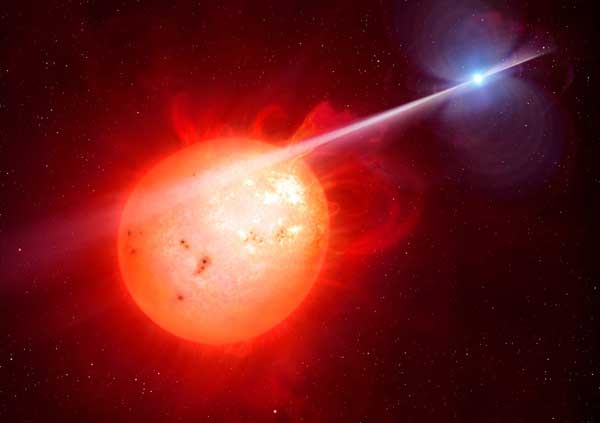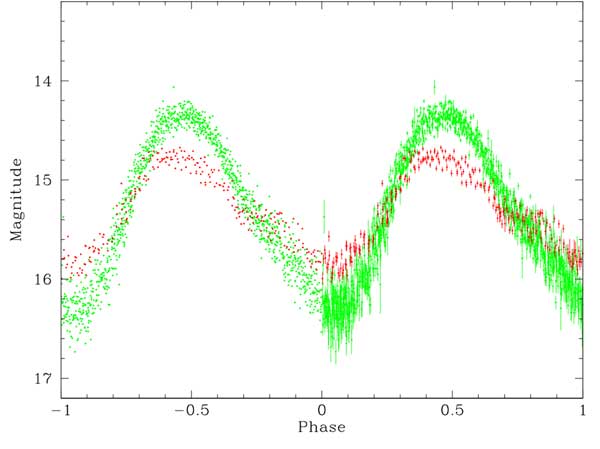Astronomy - Amateurs Help Discover Pulsing White Dwarf

An artist's impression shows the exotic binary system, AR Scorpii.
M. Garlick / University of Warwick / ESO
M. Garlick / University of Warwick / ESO
In the July 28th Nature, researchers announced the discovery of a pulsing white dwarf, part of the system 380 light-years from Earth known as AR Scorpii. Amateur astronomers have long kept an eye on AR Sco, thinking they were watching the flickering of a single variable star. But when they took more detailed observations last year, they saw entirely unexpected behavior and began a fruitful collaboration with professional astronomers to find out the answer.
A multitude of ground- and spacebased observations later, and astronomers now have a working hypothesis that explains the system. AR Sco is not one star but two: a cool red star and its companion, a white dwarf generating a lighthouse beam of energetic particles. The two revolve around each other every 3.6 hours in a precise cosmic dance. The white dwarf is spinning too, lashing its companion with the beam again and again, causing the whole system to brighten dramatically and fade away again every 1.97 minutes.
Read more about this result in European Southern Observatory’s press release.
"We've known pulsing neutron stars for nearly fifty years, and some theories predicted white dwarfs could show similar behavior,” says study coauthor Boris Gänsicke (University of Warwick). “It's very exciting that we have discovered such a system, and it has been a fantastic example of amateur astronomers and academics working together."
Josch Hambsch, an life-long astronomer and coauthor on the Nature paper, describes the research from the amateur perspective:

This chart shows the location of AR Scorpii in Scorpius, marked with a red circle. The stars of Scorpius shown here are visible with the naked eye on a dark clear night. (Click for larger version.)
IAU and Sky & Telescope
IAU and Sky & Telescope
I have been interested in astronomy since childhood — in 1975 I started out performing visual observations with a 4.25-inch Newtonian. About 25 years later, I started using a CCD camera to shoot pretty pictures, some of which even became Astronomy Pictures of the Day (e.g., September 15, 2006).
However, after a few years of CCD experience and maybe because I make a living as a scientist (nuclear physics), I switched to observing variable stars. Nowadays, you can contribute to scientific research using your CCD or DSLR. So I joined an amateur group in Belgium, where I live, that focuses on variable stars, called Vereniging voor Sterrenkunde. I also joined two other variable star groups: Groupe Européen d'Observation Stellaire in France and Bundesdeutsche Arbeitsgemeinschaft für Veränderliche Sterne in Germany, my country of origin.
Among the projects I undertook when I began observing variable stars was to monitor High-Amplitude Delta Scuti (HADS) variables, short-pulsating stars for which several maxima can be observed in a single night.. My research on this topic had already resulted already in several earlier publications.
Since weather conditions in the central part of Europe are not that favorable, many amateurs turn to armchair astronomy. It was such a group of amateurs mining databases of automatic surveys who approached me to observe AR Scorpii, a star varying 2 magnitudes in brightness and previously classified as a Delta Scuti variable. However, the changes in brightness and the star’s classification didn’t match and new observations were needed.
The star’s southern declination made it difficult to observe from central Europe, so it was fortunate that I had built my remote observatory in Chile a few years ago. The weather in the Atacama Desert is marvelous, and I began observing immediately and continued to do so for several weeks.

Franz-Josef Hambsch captured the light curve of AR Scorpii at visible wavelengths (V, green points) and infrared wavelengths (I, red points). The light curve wasn't what amateurs had expected to see from a High-Amplitude Delta Scuti variable star - this system had to have a different explanation.
I performed these observations with a 40-cm f/6.8 telescope from Orion Optics on an ASA direct drive mount DDM85. The CCD I used is an FLI ML16803 binned 3x3. I used a photometric V filter from Astrodon. I initially timed the exposure at 60 seconds, as I thought I’d need such a long exposure for a star of magnitude 14.5 to 16.5. The results show a rather scattered light curve (see the figure at right), but confirmed the period of the brightness variations, known since the 1970s. The light curve’s shape also ruled out a Delta Scuti classification.
Additional observations didn’t bring us any closer to explaining the nature of this star, so we decided to involve professional astronomers. My astrobuddies in Germany had already involved the pros in previous projects, and they brought us into contact with Boris Gaensicke at the University of Warwick in the UK. Boris found the object so fascinating that he immediately tried to convince his colleagues, who already had observing time at the Very Large Telescope (VLT), to take a spectrum of AR Sco. With the VLT spectrum in hand, and a run of high-speed photometry from the William Herschel Telescope, the ball started rolling: more professional astronomers became involved, looking at AR Sco in all available passbands.
We amateurs had never thought we'd find an object worthy of publication in Nature, but in the end that’s exactly what happened.
No comments:
Post a Comment